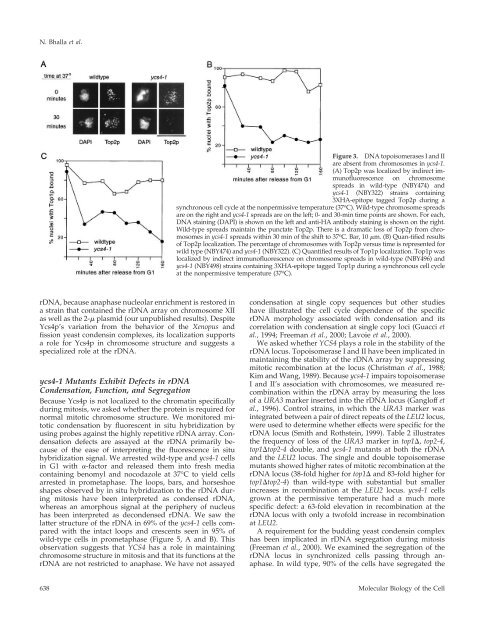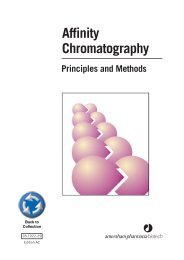Mutation of YCS4, a Budding Yeast Condensin Subunit - Molecular ...
Mutation of YCS4, a Budding Yeast Condensin Subunit - Molecular ...
Mutation of YCS4, a Budding Yeast Condensin Subunit - Molecular ...
You also want an ePaper? Increase the reach of your titles
YUMPU automatically turns print PDFs into web optimized ePapers that Google loves.
N. Bhalla et al.Figure 3. DNA topoisomerases I and IIare absent from chromosomes in ycs4-1.(A) Top2p was localized by indirect immun<strong>of</strong>luorescenceon chromosomespreads in wild-type (NBY474) andycs4-1 (NBY322) strains containing3XHA-epitope tagged Top2p during asynchronous cell cycle at the nonpermissive temperature (37 o C). Wild-type chromosome spreadsare on the right and ycs4-1 spreads are on the left; 0- and 30-min time points are shown. For each,DNA staining (DAPI) is shown on the left and anti-HA antibody staining is shown on the right.Wild-type spreads maintain the punctate Top2p. There is a dramatic loss <strong>of</strong> Top2p from chromosomesin ycs4-1 spreads within 30 min <strong>of</strong> the shift to 37 o C. Bar, 10 m. (B) Quan-tified results<strong>of</strong> Top2p localization. The percentage <strong>of</strong> chromosomes with Top2p versus time is represented forwild type (NBY474) and ycs4-1 (NBY322). (C) Quantified results <strong>of</strong> Top1p localization. Top1p waslocalized by indirect immun<strong>of</strong>luorescence on chromosome spreads in wild-type (NBY496) andycs4-1 (NBY498) strains containing 3XHA-epitope tagged Top1p during a synchronous cell cycleat the nonpermissive temperature (37 o C).rDNA, because anaphase nucleolar enrichment is restored ina strain that contained the rDNA array on chromosome XIIas well as the 2- plasmid (our unpublished results). DespiteYcs4p’s variation from the behavior <strong>of</strong> the Xenopus andfission yeast condensin complexes, its localization supportsa role for Ycs4p in chromosome structure and suggests aspecialized role at the rDNA.ycs4-1 Mutants Exhibit Defects in rDNACondensation, Function, and SegregationBecause Ycs4p is not localized to the chromatin specificallyduring mitosis, we asked whether the protein is required fornormal mitotic chromosome structure. We monitored mitoticcondensation by fluorescent in situ hybridization byusing probes against the highly repetitive rDNA array. Condensationdefects are assayed at the rDNA primarily because<strong>of</strong> the ease <strong>of</strong> interpreting the fluorescence in situhybridization signal. We arrested wild-type and ycs4-1 cellsin G1 with -factor and released them into fresh mediacontaining benomyl and nocodazole at 37°C to yield cellsarrested in prometaphase. The loops, bars, and horseshoeshapes observed by in situ hybridization to the rDNA duringmitosis have been interpreted as condensed rDNA,whereas an amorphous signal at the periphery <strong>of</strong> nucleushas been interpreted as decondensed rDNA. We saw thelatter structure <strong>of</strong> the rDNA in 69% <strong>of</strong> the ycs4-1 cells comparedwith the intact loops and crescents seen in 95% <strong>of</strong>wild-type cells in prometaphase (Figure 5, A and B). Thisobservation suggests that <strong>YCS4</strong> has a role in maintainingchromosome structure in mitosis and that its functions at therDNA are not restricted to anaphase. We have not assayedcondensation at single copy sequences but other studieshave illustrated the cell cycle dependence <strong>of</strong> the specificrDNA morphology associated with condensation and itscorrelation with condensation at single copy loci (Guacci etal., 1994; Freeman et al., 2000; Lavoie et al., 2000).We asked whether <strong>YCS4</strong> plays a role in the stability <strong>of</strong> therDNA locus. Topoisomerase I and II have been implicated inmaintaining the stability <strong>of</strong> the rDNA array by suppressingmitotic recombination at the locus (Christman et al., 1988;Kim and Wang, 1989). Because ycs4-1 impairs topoisomeraseI and II’s association with chromosomes, we measured recombinationwithin the rDNA array by measuring the loss<strong>of</strong> a URA3 marker inserted into the rDNA locus (Gangl<strong>of</strong>f etal., 1996). Control strains, in which the URA3 marker wasintegrated between a pair <strong>of</strong> direct repeats <strong>of</strong> the LEU2 locus,were used to determine whether effects were specific for therDNA locus (Smith and Rothstein, 1999). Table 2 illustratesthe frequency <strong>of</strong> loss <strong>of</strong> the URA3 marker in top1, top2-4,top1top2-4 double, and ycs4-1 mutants at both the rDNAand the LEU2 locus. The single and double topoisomerasemutants showed higher rates <strong>of</strong> mitotic recombination at therDNA locus (38-fold higher for top1 and 83-fold higher fortop1top2-4) than wild-type with substantial but smallerincreases in recombination at the LEU2 locus. ycs4-1 cellsgrown at the permissive temperature had a much morespecific defect: a 63-fold elevation in recombination at therDNA locus with only a tw<strong>of</strong>old increase in recombinationat LEU2.A requirement for the budding yeast condensin complexhas been implicated in rDNA segregation during mitosis(Freeman et al., 2000). We examined the segregation <strong>of</strong> therDNA locus in synchronized cells passing through anaphase.In wild type, 90% <strong>of</strong> the cells have segregated the638<strong>Molecular</strong> Biology <strong>of</strong> the Cell
















